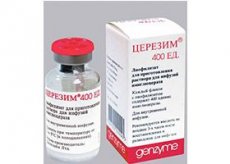Medical expert of the article
New publications
Preparations
Cerezyme
Last reviewed: 03.07.2025

All iLive content is medically reviewed or fact checked to ensure as much factual accuracy as possible.
We have strict sourcing guidelines and only link to reputable media sites, academic research institutions and, whenever possible, medically peer reviewed studies. Note that the numbers in parentheses ([1], [2], etc.) are clickable links to these studies.
If you feel that any of our content is inaccurate, out-of-date, or otherwise questionable, please select it and press Ctrl + Enter.

A drug that is actively used to treat patients with type 1 or type 3 Gaucher disease. It is used for long-term enzyme replacement therapy in patients with and without neuropathic manifestations.
Indications Cerezyme
Among the main symptoms of the disease that may be the basis for prescribing the drug, the following should be highlighted:
- Anemia (except iron deficiency anemia).
- Bone diseases (except for diseases that are accompanied by vitamin D deficiency).
- Thrombocytopenia.
- Splenomegaly or hepatomegaly.
Release form
The product is available in the form of a lyophilisate, which can be used to prepare two solutions for infusions (200 and 400 U). The drug can be purchased in small 20 ml vials at the pharmacy. The drug contains the active component imiglucerase 200 (400) U. This is glucocerebrosidase in a modified form, which is created using recombinant DNA technology from the ovaries of Chinese hamsters.
Pharmacodynamics
Ceramide and glucose are catalyzed by imiglucerase from the hydrolysis of the glucolipid glucocerebroside through normal degradation of membrane lipids. Glucocerebroside is mainly formed through hematopoietic metabolism in cells. In Gaucher disease, the patient exhibits a deficiency in the activity of the enzyme β-glucocerebrosidase. Because of this, glucocerebroside lipids accumulate in tissue macrophages. They are called "Gaucher cells" and can become completely overloaded with this lipid.
Gaucher cells can typically be found in the bone marrow, liver, intestines, spleen, kidneys, and even lungs. Secondary manifestations of the disease are considered by experts to be anemia and thrombocytopenia, which lead to severe hepatosplenomegaly. Perhaps the most serious complications of Gaucher disease are complications in skeletal development (osteonecrosis, remodeling failure, osteopenia).
Pharmacokinetics
After intravenous infusions of four doses of this drug, the patient achieves stable enzyme activity within an hour. After the procedure, enzyme activity in the plasma begins to decrease within 10 minutes. Some experts believe that the duration of the infusion and the dosage of the drug do not affect the indicators, but clinical studies were conducted on a small number of patients.
Dosing and administration
Gaucher disease is multisystemic and heterogeneous, so the correct dosage can only be determined by the attending physician after examining the patient. The infusion is administered intravenously using a dropper for one to two hours. The rate of administration of the drug should not exceed 1 U/kg/min. The first two weeks, the dose is 60 U/kg. This dose is administered once. Treatment should be continued if no allergic reactions to the drug have been detected. The drug is usually administered once every two weeks, but the dosage is gradually increased.
 [ 1 ]
[ 1 ]
Use Cerezyme during pregnancy
At the moment, there is not enough information about how exactly Cerezyme affects the health of pregnant women and fetal development. That is why its use in treatment during pregnancy is not recommended. Only in case of extreme necessity can Cerezyme be prescribed by the attending physician.
Contraindications
- Intolerance to the active component of the product.
- Allergy to the drug.
Side effects Cerezyme
- Vomit.
- Diarrhea.
- Nausea.
- Dizziness.
- Headaches.
- Skin rashes.
- Angioedema.
- Generalized itching.
- Bronchospasms.
- Dyspnea.
- Discomfort at the injection site.
- Increased body temperature.
Overdose
There have been no reported cases of drug overdose.
Storage conditions
The drug must be stored in a cool place, preferably in a refrigerator, at a temperature of +2 to -8 degrees.
 [ 4 ]
[ 4 ]
Shelf life
The shelf life is 2 years. Do not use after this date.
Attention!
To simplify the perception of information, this instruction for use of the drug "Cerezyme" translated and presented in a special form on the basis of the official instructions for medical use of the drug. Before use read the annotation that came directly to medicines.
Description provided for informational purposes and is not a guide to self-healing. The need for this drug, the purpose of the treatment regimen, methods and dose of the drug is determined solely by the attending physician. Self-medication is dangerous for your health.

